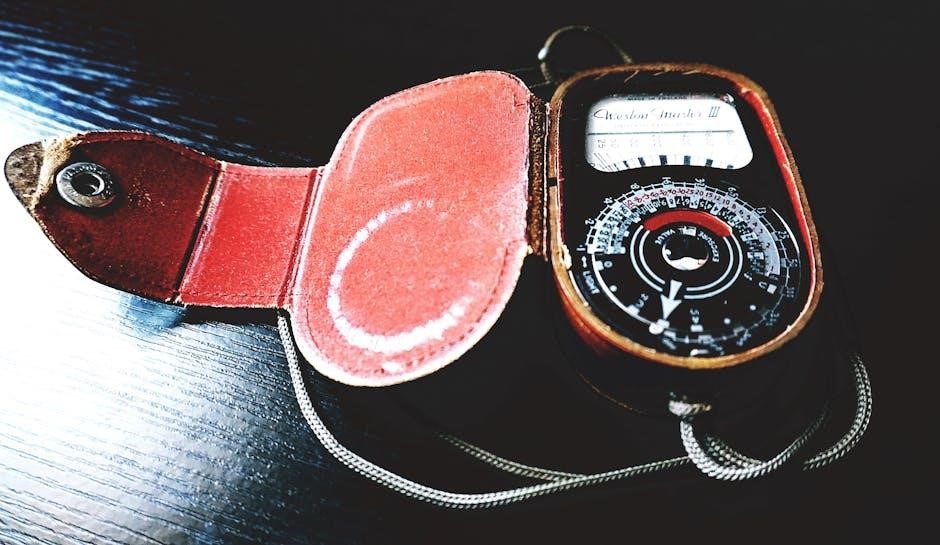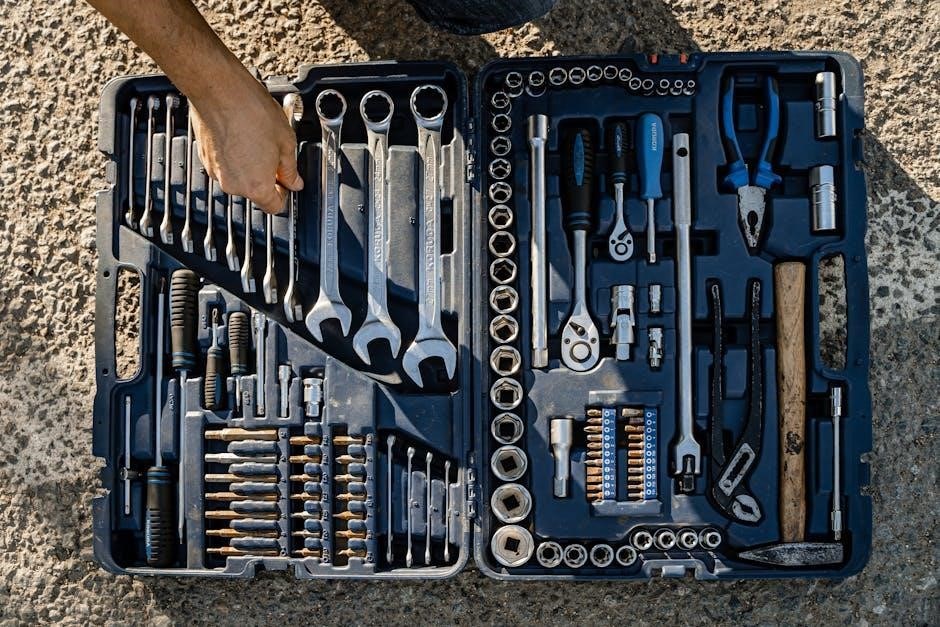The manual transfer case is a critical component in four-wheel-drive vehicles, enabling power distribution between front and rear axles. It allows drivers to switch between two-wheel and four-wheel drive modes, enhancing traction and control in various driving conditions. This section provides an overview of its function, importance, and operational modes.
1.1 Definition and Purpose
The manual transfer case is a mechanical component in four-wheel-drive vehicles that enables the distribution of engine power between the front and rear axles. Its primary purpose is to allow drivers to manually switch between two-wheel drive (2WD) and four-wheel drive (4WD) modes, enhancing traction, control, and stability in various driving conditions. This system is essential for optimizing vehicle performance in both on-road and off-road scenarios, ensuring proper power delivery when needed.
1.2 Importance in Four-Wheel-Drive Systems
The manual transfer case is vital in four-wheel-drive systems as it ensures optimal power distribution between axles. By enabling drivers to switch modes, it improves vehicle stability and control on diverse terrains. This component is crucial for enhancing traction in low-grip conditions, reducing wheelspin, and preventing drivetrain strain. Its reliability directly impacts the vehicle’s off-road performance and overall durability, making it a cornerstone of four-wheel-drive functionality and a key factor in maintaining driver safety and control in challenging environments.
How the Manual Transfer Case Works
The manual transfer case operates using mechanical components like gears and levers, allowing drivers to manually switch between two-wheel and four-wheel drive modes for optimal traction control.
2.1 Mechanical Components and Operation

The manual transfer case consists of gears, bearings, and a shift mechanism. It transfers power from the transmission to the front and rear axles. Drivers engage the system using a lever or electronic switch, which activates synchronizers or hub locks to distribute torque. This mechanical operation ensures reliable performance in various driving conditions, maintaining traction and control. The simplicity of its design makes it durable and suitable for rugged off-road use.
2.2 Electronic Controls and Sensors
Modern manual transfer cases often integrate electronic controls, utilizing sensors to monitor wheel speed, throttle position, and torque demand. These sensors communicate with the vehicle’s computer to optimize power distribution. Electronic controls enable seamless mode transitions, reducing driver input effort. They also enhance system reliability by minimizing mechanical wear. Advanced systems may include features like automatic mode switching based on traction conditions, improving overall vehicle performance and adaptability in diverse driving scenarios.

Modes of Operation
The manual transfer case operates in three primary modes: Two-Wheel Drive (2Hi), Four-Wheel Drive High (4Hi), and Four-Wheel Drive Low (4Lo). Each mode is designed to optimize traction and control in specific driving conditions, ensuring enhanced vehicle performance and stability.
3.1 Two-Wheel Drive (2Hi)
The Two-Wheel Drive (2Hi) mode is the default setting for most vehicles, delivering power exclusively to the rear axle. This mode is ideal for normal on-road driving, providing optimal fuel efficiency and smooth handling. In 2Hi, the transfer case disconnects the front drivetrain, reducing wear on components and minimizing power loss. It is recommended for paved roads and dry conditions, where additional traction is unnecessary. Switching to 2Hi ensures efficient performance and is the preferred mode for everyday driving scenarios.
3.2 Four-Wheel Drive High (4Hi)
The Four-Wheel Drive High (4Hi) mode engages both front and rear axles simultaneously, providing enhanced traction for light off-road conditions or slippery surfaces. Unlike 4Lo, it operates at the same speed as 2Hi, making it suitable for higher-speed situations. In 4Hi, the transfer case locks the front and rear driveshafts together, ensuring equal power delivery to all wheels. This mode is ideal for gravel roads, muddy trails, or icy surfaces but should not be used on dry pavement to avoid drivetrain damage.
3.3 Four-Wheel Drive Low (4Lo)
Four-Wheel Drive Low (4Lo) is designed for extreme off-road conditions, such as steep inclines, rock crawling, or heavy towing. It engages a lower gear ratio, providing maximum torque at low speeds. The transfer case directs power to both axles simultaneously, with gears and driveshafts working together to enhance traction. This mode is ideal for situations requiring precise control and high torque but should not be used at high speeds. It is essential for overcoming challenging terrain effectively. Always use 4Lo cautiously and avoid paved roads to prevent damage.

When to Use Each Mode
Selecting the right mode depends on driving conditions. Use 2Hi for normal on-road driving, 4Hi for improved traction on slippery surfaces, and 4Lo for extreme off-road challenges.
4.1 On-Road Driving
For on-road driving, the 2Hi mode is recommended as it provides optimal performance and fuel efficiency. This mode powers only the rear wheels, suitable for dry, paved surfaces. Avoid using 4Hi on dry roads, as it can cause unnecessary wear on the transfer case and drivetrain. Always switch to 2Hi when driving on highways or smooth surfaces to maintain proper vehicle handling and performance. Check your owner’s manual for specific recommendations tailored to your vehicle.

4.2 Off-Road and Low-Traction Conditions

For off-road and low-traction conditions, use 4Hi or 4Lo modes. 4Hi mode is suitable for light off-road driving, while 4Lo provides maximum traction and control in extreme conditions like steep inclines or deep mud. Always engage the correct mode before entering challenging terrain to prevent system damage. Avoid sudden throttle changes and maintain steady speed. Ensure the vehicle is stationary and on a level surface before switching modes. Regular maintenance is essential for optimal performance in harsh environments.
Maintenance and Care
Regular servicing, fluid checks, and component inspections are essential for optimal manual transfer case performance. Addressing leaks and wear early prevents major repairs and ensures reliability.
5.1 Regular Servicing
Regular servicing of the manual transfer case involves inspecting gears, bearings, and seals for wear or damage. Flushing and replacing the transfer case fluid according to the manufacturer’s schedule is crucial to maintain lubrication and prevent corrosion. Additionally, ensuring all electrical connections are clean and secure helps avoid malfunctions. Proper servicing not only extends the lifespan of the component but also ensures smooth operation in all driving modes, preventing unexpected breakdowns during off-road adventures or daily commutes.
5.2 Fluid Checks and Replenishment
Regular fluid checks are essential for the manual transfer case’s health. Low fluid levels or contamination can lead to premature wear and component failure. Always use the manufacturer-recommended fluid type to ensure compatibility and optimal performance. During checks, look for signs of degradation or leaks. Replenish fluid as needed, following the specified procedure to avoid introducing air into the system. Proper fluid maintenance ensures smooth gear engagement and protects against excessive heat buildup, prolonging the transfer case’s lifespan and reliability. Always refer to the service manual for specific guidelines.
Troubleshooting Common Issues
Common issues include unusual noises, vibration, or difficulty shifting modes. Check for fluid leaks, worn gears, or faulty sensors. Consult the service manual for diagnostic guidance.
6.1 Symptoms of Transfer Case Failure
Common symptoms of transfer case failure include loud grinding or clicking noises, vibration during acceleration, and difficulty shifting between modes. Slippage or loss of traction in four-wheel drive, fluid leaks, or unusual odors may also indicate malfunction. Drivers might experience reduced performance, especially in low-traction conditions. Early detection of these issues is crucial to prevent further damage and ensure vehicle safety. Regular maintenance and inspections can help identify potential problems before they escalate.

6.2 Diagnostic Steps and Solutions

Diagnosing transfer case issues begins with checking fluid levels and inspecting for leaks. Use scan tools to identify error codes, and visually examine for worn or damaged components. Common solutions include replacing faulty sensors, seals, or gears. In severe cases, rebuilding or replacing the transfer case may be necessary. Regular maintenance, such as fluid changes, can prevent many issues. Always consult a professional for complex repairs to ensure proper functionality and prevent further damage.

Upgrades and Modifications
Upgrades include heavy-duty gears, bearings, and enhanced control systems for improved durability and performance. Modifications can optimize torque distribution and enhance low-speed crawling capabilities in off-road conditions.
7.1 Aftermarket Parts and Enhancements
Aftermarket parts for the manual transfer case include heavy-duty gears, reinforced housings, and upgraded bearings to enhance durability. Electronic control modules can improve shifting precision and torque distribution. High-performance lubricants reduce friction and heat, extending component life. These enhancements are ideal for off-road enthusiasts seeking improved reliability and capability in demanding conditions. Upgraded components ensure smoother operation and better adaptability to extreme terrains, making them a popular choice for modified 4WD vehicles. Proper installation and alignment are crucial for optimal performance.

7.2 Performance Improvements
Upgrading the manual transfer case with high-strength materials and advanced lubrication systems enhances durability and reduces wear. Synchronization kits improve shifting smoothness and reduce effort, while torque-biasing differentials optimize power delivery. Custom ratios and lightweight components increase efficiency and responsiveness. These modifications boost traction and stability, especially in challenging off-road conditions. Enhanced thermal management systems prevent overheating under heavy use, ensuring consistent performance. Overall, these improvements elevate the transfer case’s capability, making it more reliable for demanding applications and extreme terrains.
This manual has covered the essential aspects of the manual transfer case, from its basic operation to advanced modifications. Understanding its modes, maintenance, and troubleshooting ensures optimal performance. Whether on-road or off-road, mastering the transfer case enhances vehicle control and durability. Regular servicing and upgrades can further improve its reliability. By following this guide, drivers can maximize their vehicle’s potential and tackle challenging terrains with confidence. Safe driving and continued learning are key to getting the most out of your four-wheel-drive system.
